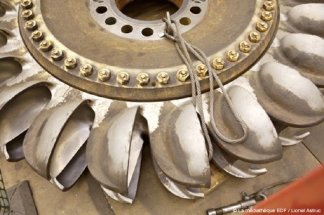Hydropower
Introduction
Wind and hydropower are indirect solar energy generated by the movement of air masses and water resulting from the cyclical warming of the Earth by the sun.
Hydraulic energy is the potential energy that water gets from altitude. It results from the action of sunlight through the water cycle, evaporated from the surface of the earth, then condensed as rain. There is large hydro, which was discussed in the section on electricity, and micro-hydro, or low-power hydro (less than 8 MW).
Small plants, as large hydro plants, can be installed on vertical waterfall of highly variable height of fall (1.5 to 400 m), and significantly contribute to local electricity or mechanical power needs. Historically, water mills have played a major role in industrial and commercial development.
The hydro turbines are of three types depending on the height of fall:
Pelton turbines;
Francis turbines;
Kaplanturbines.
Pelton turbines
Impulse Pelton turbines (Figure below, source EDF) are used for heights between 200 and 1500 m.

Francis turbines
Reaction Francis turbines (Figure below, source EDF) are used for heights between 30 and 200 m.

Kaplan turbines
Kaplan turbines (Figure below, source EDF) are used for low hydraulic heads (below 30 m). The one shown in the figure is part of the La Rance tidal plant in France.

